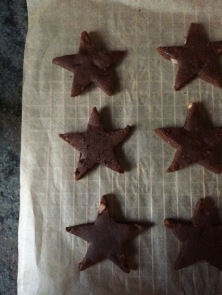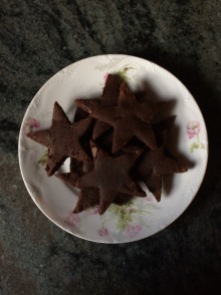This gingerbread recipe is not for the faint hearted. Potent ginger, molasses, caraway, and citrus flavors blend sweet and savory, spicy and floral. This is not necessarily surprising. Heavily spiced treats are a British holiday tradition (take a look at these mince pie and gingerbread recipes I’ve made in the past). Gingerbread recipes are remarkable for their strong flavors and interesting designs. Seventeenth-century moulds for figures and patterns — like these on Ivan Day’s Historic Food website — demonstrate the decorative potential of this cookie dough. Whether gingerbread was sold at a Christmas market or prepared for display and consumption in the home, it was meant to be both flavorful and beautiful.

Victoria and Albert Museum, London
This early nineteenth-century English gingerbread mould, from the Victoria and Albert Museum, depicts a king and queen standing side-by-side. Others moulds from the period depict swaddled infants, winged figures, shepherds, St George, the Agnus Dei, fashionable ladies with fans, and fruit baskets. Although gingerbread men or houses are our culinary commonplaces in the twenty-first-century, historical gingerbread recipes and moulds reveal a range of other shapes.
Original Recipe

To Make Ginger Bread
8
Take one Peck of flower a quarter of a pound
of ginger a quarter of a pound of Carraway
seeds one ounce of coriander seeds bruise the seeds
Tenn Eggs Tenn pound of Treakcle one pound of
Orange & one pound of Cittern bake them in a
Slow Oven
{anne
Western
Zk G
In the seventeenth century, treacle could refer to a range of sugar syrups of varying viscosity and flavor intensity from what a British baker would now call “golden syrup” to modern treacle and American blackstrap molasses. These syrups were a byproduct of sugar processing, and were widely available because of their use in the thriving rum industry and their connection to slavery and colonial trade routes.
I prepared 1/12 batch of the original recipe using American molasses and made more than two dozen gingerbread stars! The original amounts are a monumental undertaking either for sale, large-format gingerbread displays, or a grand celebration.
Updated Recipe
3 1/3 c flour
2T ground ginger
2T candied ginger, chopped small
1T caraway seeds
1t coriander seeds
1/3 c candied orange peel, chopped small
1/3 c candied citron
1 egg
1 1/4 c molasses (American bakers) or treacle (British bakers)
Preheat oven to 350F. Line cookie sheets with baking parchment or grease with butter or spray.
Mix gingerbread ingredients in a large bowl. Stir until a soft, slightly sticky dough forms.
On a lightly floured surface, roll out until 1/4 inch thick. Cut out shapes and/or stamp with designs.
Bake 10-15 minutes. The bottoms will feel set, but the cookies will still be soft.
Cool on racks for 10 minutes.
The Results
This gingerbread is packed with flavor and could be easily be stamped, shaped, or used to construct a house, figure, or any other monument you might dream up. The molasses dominates any bite that does not include a bit of citrus. If I were to make this again, I might swap out half of the molasses for honey or a lighter syrup.
This recipe comes from my year-long investigation of Folger Shakespeare Library manuscript V.b.380 alongside students and collaborators.







